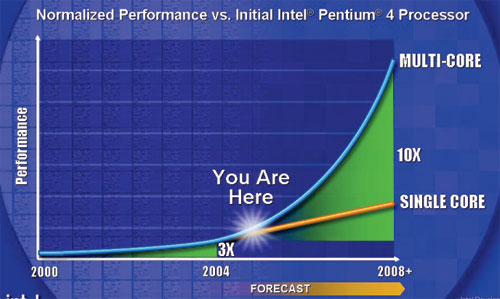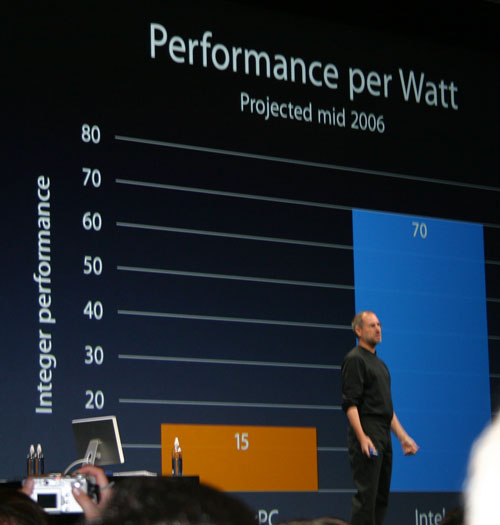Intel's Core 2 Extreme QX6700: The Multi-core Era Begins
by Anand Lal Shimpi on November 2, 2006 2:14 AM EST- Posted in
- CPUs
More Cores - The Ticket to Power Efficiency?
When Intel started on its quest for greater power efficiency we heard much about how the ticket would be more cores and multi-threaded applications. Instead of focusing on increasing clock speed Intel turned to the world and admitted that its gigahertz race was foolish, and that the next decade of performance improvements would come from increasing the number of cores per processor, not clock speed.
Back in 2005 Intel displayed the following chart, plotting a new curve for performance made possible mostly by the move to multi-core processors:

But at the same time, just as Intel had learned from the Pentium 4 family, an endless pursuit of performance (whether in the form of higher clock speed or more cores) will simply run us into another power wall. So as we were hearing about the performance improvements the multi-core era would bring us, we were also being told that Intel would not only improve the performance vector, but performance-per-watt as well. In fact, Apple cited Intel's focus on performance-per-watt as the driving factor in its adoption of Intel CPUs:

The introduction of Intel's Core microarchitecture proved one very important point: individual core improvements, as well as simply adding more cores, will both be necessary to drive better performance per watt in future microprocessors.
Looking at Intel's own numbers, the move from one to two cores improved performance per watt on the mobile side by around 50% while the move from NetBurst to Core on the desktop side increased performance per watt by a magnitude of 5x.
But is Kentsfield nothing more than a cleverly masked return to an older Intel? An Intel that used its manufacturing abilities to out-market AMD but left us with much higher power consumption than we wanted (and needed) to have? With Kentsfield we have two Conroes on a single chip, with no tweaks to the cores and very inefficient power management between the two die. Is this really no different than when Intel simply pushed out CPUs with higher clock frequencies, without addressing efficiency, to really turn up the heat on AMD?
Intel has said that it is committed to improving performance and performance per watt, but it was time to test that commitment with Kentsfield.
To put Intel's marketing and IDF presentations to the test we took six of our multithreaded benchmarks and ran them on a handful of configurations. Instead of just measuring performance, we also looked at average power usage during the benchmark and obviously, performance per watt. While all six benchmarks benefit from dual core CPUs, only four of them show a gain when using a quad core CPU, which should be useful in illustrating a very important correlation between number of threads and performance per watt.










59 Comments
View All Comments
Staples - Thursday, November 2, 2006 - link
I will eventually be buying an E6600 but I was hoping we'd see a price drop when these quad cores came out. Now they have and we see that the cheapest one is over $800, the price of the E6600 will probably not drop for a while because these processors are not in the same market.rqle - Thursday, November 2, 2006 - link
Price doesnt really interest me as much, the fact that i have a very hard time getting a lot of low end Athlon64 around 2.8ghz, mines seem to max out at around 2.7ghz. Seem like most athlon for some reason like 2.3-2.4 and sometime lower while a whole group at my lan party have no problem push a E6300 past 3.1ghz.Brunnis - Thursday, November 2, 2006 - link
The article seems to state that Kentsfield is more efficient that Conroe. This conclusion comes from power measurements of complete systems. This is a little misleading, since a large chunk of that power is consumed by the rest of the system. Since the CPU only makes up a part of the power consumption, but accounts for a very large performance increase, the efficiency is bound to increase when looking at system power consumption.The Kentsfield CPU itself shouldn't be any more efficient than Conroe. That said, there isn't anything wrong in looking at system power consumption and drawing the conclusion that the computer is more efficient with the quad core. I just don't think that the article was very clear on this, though.
smilingcrow - Thursday, November 2, 2006 - link
The power efficiency figures would look different if a lower power PC had been used as a test bed; the use of dual X1900XT cards distorts the figures to a degree. These CPUs are currently only particularly useful for areas where Crossfire setups are not generally relevant.I used the Anandtech data along with my own C2D data from testing low power systems and came up with the following. The extrapolated figures show the efficiency of each CPU as a percentage of that of the QX6700, which is the most efficient in these two tests:
CPU/Anand PC/My PC
3dsmax7
QX6700 – 100/100
Q6600 – 92.3/92.9
X6800 – 74.7/80.7
E6700 – 69.7/75.7
DivX 6.1
QX6700 – 100/100
Q6600 – 98.4/99.01
X6800 – 92.5/99
E6700 – 87.4/94.4
The PC I used for a comparison uses ~60W less at load than Anandtech’s setup which results in:
130W v 189W for the E6700
172W v 230.5W for the QX6700.
System - Asus P5W DH Deluxe, Nvidia 6200TC, 2 x 1GB DDR2-667, Samsung P120 250GB SATA.
The one thing that was missing for me was the power consumption at idle, as I’d imagine that the dual Dice Kentsfield would take a big hit here. Xbitlabs have figures showing idle power consumption, but they are measured with C1E & EIST disabled which makes them a bit pointless in my eyes. Kentsfield gets a spanking in this comparison although it matches an FX-62.
EnzoM3 - Thursday, November 2, 2006 - link
I can only make assumptions, without any test beds here. Since Quad core is simply two dies of Conroe as this article pointed out, the power consumption of the Quad core should double that of Core Duo. If you use that assumption to compute performance per watt, regardless of what the actual numbers are (as long as Quad uses twice the power of Duo), then Quad actually has lower performance per watt than Duo across the board.Sunrise089 - Thursday, November 2, 2006 - link
If you could isolate the CPU only, you're certainly correct, and PPW will decrease with each additional core due to diminishing returns from scaling. Fortunatly CPUs are part of an entire PC, so when the choice can be painted as quad-core versus two dual-core machines, then the numbers look much better.ATWindsor - Thursday, November 2, 2006 - link
Yeah i agree, the more the rest of the system uses, the more "flawed" the numbers will be, lets say, for arguments sake, that a CPU uses 50 watts, and a twice as fast one uses 200 watts. Tut the rest of the system uses 300 watts, then the total system will use 350 watts in the fist case, and the twice as fast one will use 500 watts, so if you take the whole system numbers, the more power-hungry core will seem like it gives more permformanve per watt, but if you only look at the CPUs them self, the picture is diffrent, the less powerhungry CPU has twice the performance per watt.JarredWalton - Thursday, November 2, 2006 - link
You are right that we could be more clear. You can think in terms of efficiency that we're looking at two dual core systems vs. one quad core if you'd like. If we could isolate just the CPU power draw, we could get real CPU efficiency, but doing so is very difficult.PrinceGaz - Thursday, November 2, 2006 - link
Some sites have indeed isolated the CPU power draw by modifying mobos so that current draw as well as voltage on certain pins can be measured. It is, as you say, very difficult however and each platform you wish to test needs its own modded mobo.One simpler way to at least get a rough idea of actual power comsumption (which could be easily calibrated to provide more accurate figures), and a quite accurate measure of relative power consumption would be to measure the heat given off rather than the electricity going in.
The most obvious way to do that would seem to be with a modified water-cooling setup where instead of the heat being dissipated by an external radiator into air, it is instead transferred into a *large* insulated tank of water with an accurate digital thermometer monitoring the water temperature. This tank of water is not circulated through the water-cooling system, it is there merely for the heat to be dumped into. You then measure the rate at which the temperature rises which provides a good guide to power consumption. You might start at 20C and could probably run the tests up until the water reaches about 40C without any problems, probably 45C would still result in the CPU being kept within safe temperatures.
With a 10-litre tank, you would have 10Kg of water, and each Kg requires about 4.2KJ of energy to heat up by 1C, so it would take about 42KJ to heat up that tank of water by 1C. 42KJ is equivalent to 42KW for 1 second, or more realistically, 42 watts for 1000 seconds (about sixteen and a half minutes). You can probably see where I'm going here: a processor using about forty watts of power would heat up the tank of water by about 4C per hour. Eighty watts would be 8C per hour, and so on. Although not all the energy used by the processor will be dumped in the water due to heat being lost elsewhere, the vast majority of it will be and it will be consistent between different processor models.
If you want an exact figure for power consumption, or rather heat dissipation, then the system could be calibrated by connecting it to a CPU shaped heater element fed with a measured amount of power. Take measurements of the rate of temperature rise at twenty watt intervals up to say two hundred watts (I suspect the line will be fairly linear above about 40W) and you can now say with a good degree of accuracy how much power a given CPU is actually using.
As I say, that's one way you could do it and one which in theory should work very well.
Furen - Thursday, November 2, 2006 - link
Wow, that's a insanely round-about way of measuring power draw. You can also measure voltage and current draw at the CPU voltage VRMs. Regardless, CPU power draw truly doesn't matter with this product since it is two of the older products packed into a single package, no new silicon or anything of the sort. What this means is that theoretical efficiency should be the same but in the real world it'll be slightly worse (due to threading inefficiency). That said, measuring power draw for the whole system does measure the system's ability to make the most out of its power draw.